Dear Reader,
What might an archaeologist who studies expressions of grief through historical cemeteries and a midwife anthropologist who studies care have in common? A lot, apparently. Besides the more evident connection of the two poles of life, birth and death, we are also both concerned with the affective dimensions of experience (i.e., feelings) as subjects of academic inquiry.
We intuitively knew there were intriguing links between our areas of study, and after some time talking we were surprised to learn that care exists in both of our work. Perhaps it may be more evident in Emily’s work given that she is studying care in midwifery practices, but care also exists in Bailey’s work through “heritage” management strategies. In both of our scholarly areas, care is not limited to people, which led to some interesting conversations about the ways in which care is manifest.
Excellent! We had something to write about. The next question came about quickly: how do we actually write collaboratively? For us, it resulted in being experimental and being unafraid to try something different. We wanted both of our voices present, both separately and intertwined together. So, we decided to go a little retro and become pen pals. However, due to our twenty-first century desire to receive prompt replies, we opted for the more recent innovation of email.
After an initial discussion where we found care as our topic to write about, we decided that Bailey would start the correspondence, then Emily would reply, and that we would see where it took as. After four emails in total, we were satisfied with the ground we had covered.
We then worked on bookending our emails with an introduction to present our topic and process, and a conclusion to reiterate some key takeaways. To do this, we bounced a Word document back and forth through email, each of us taking our turn at writing and editing the introduction and conclusion, slightly reminiscent of our initial email chain. The result is this final product. Enjoy our correspondence on care.
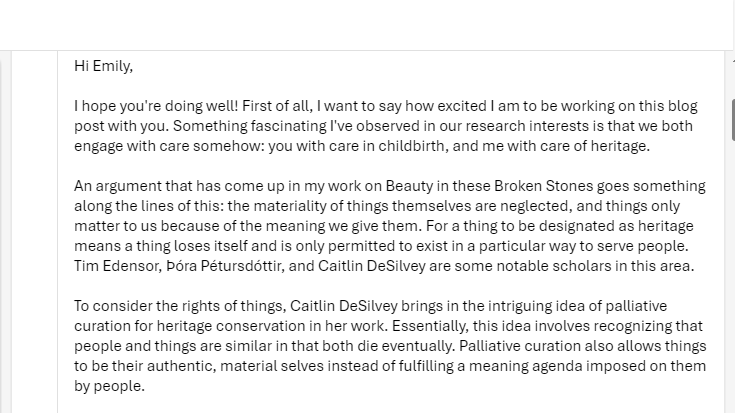
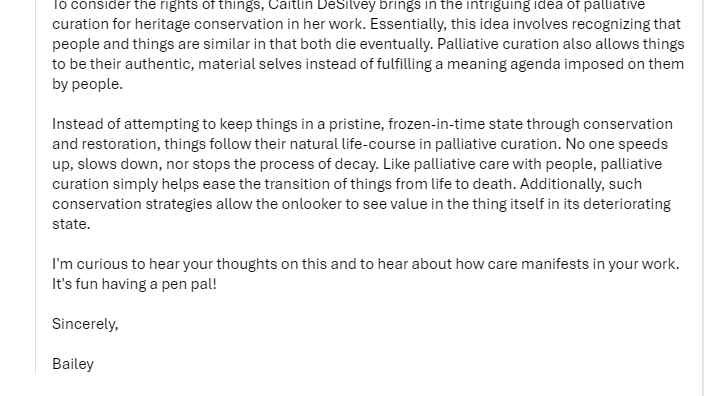

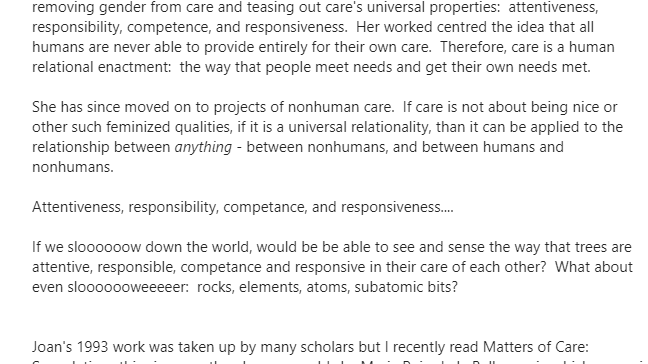
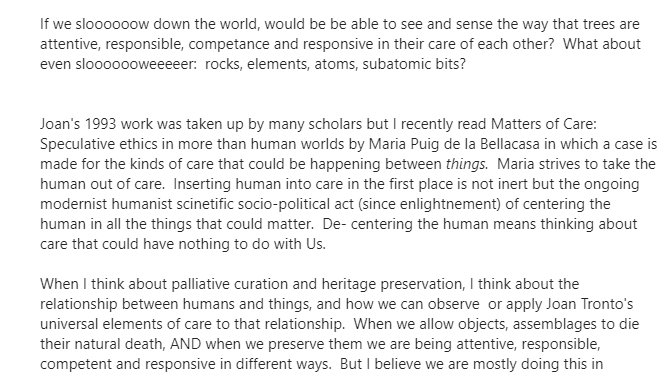
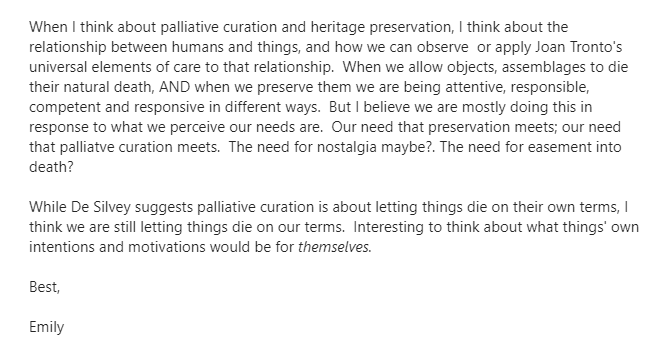
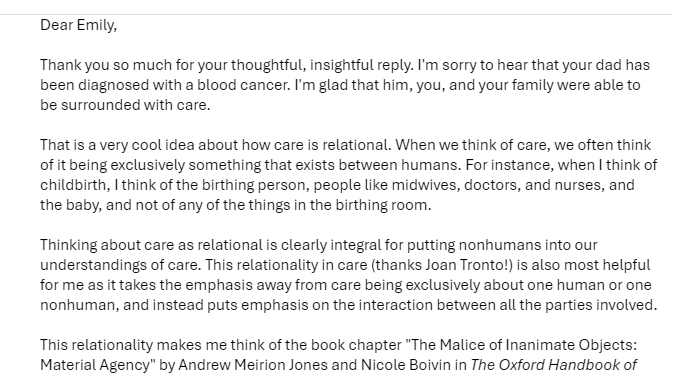
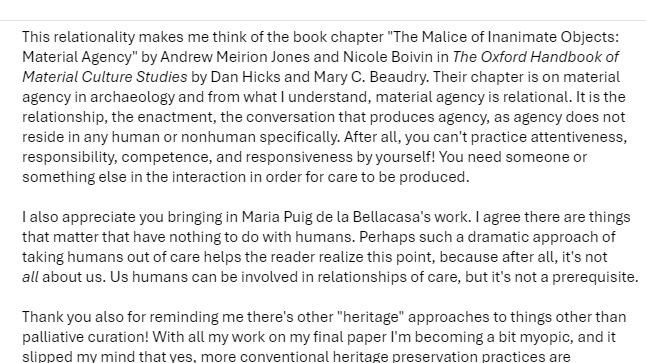

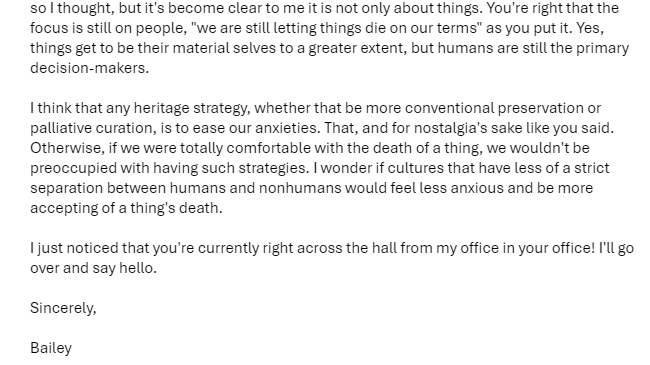
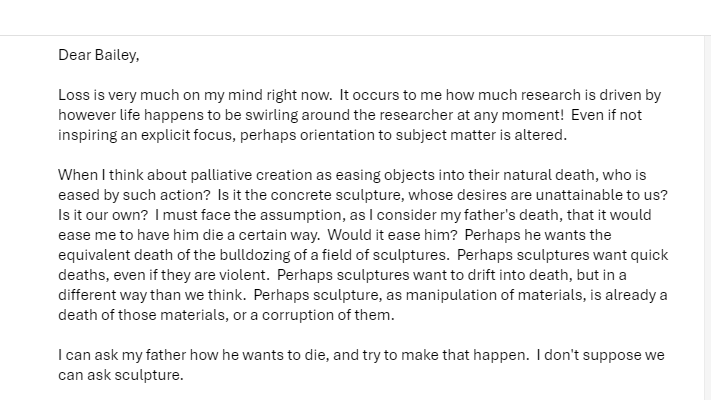
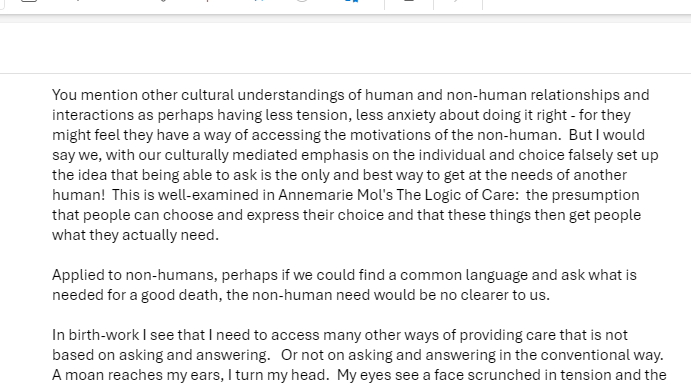
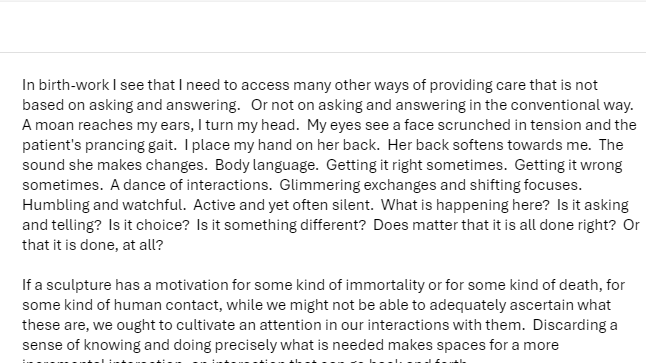

Care is much broader than most people think it is. We both recognize that decentering humans allows speculative space for reimagining the boundaries of care, and that thinking of care as relational allows us to see care as something that is made through an interaction, which can include or be completely made up of nonhumans. Care is done in the space between to and for.
In our culturally mediated context, we cannot know what a human or a nonhuman truly need – asking doesn’t necessarily get us closer to that, even for humans. Asking is always as politically heavy, laden with assumptions, and constrained by resources as care provision is. And while we think we might be able to ask nonhumans, if we could learn their languages, would we not run into the same dilemma? So what are we to do then? How do we understand what a person or a thing needs when going through a birth or a death? We believe we should orient our attention, whether that be with toward a pregnant client or a sculpture on a rural homestead in Manitoba, and care will be produced from our interactional attunement. Emily engages in “a dance of interactions” with her clients. Bailey is grappling with palliative curation and similar ideas for modern ruins. With any of our work we may not get it right, but we do it, shift and do it again, shift and do it again.
And now, we turn our email correspondence over to you. What do you think?
All the best,
Emily & Bailey
P.S. This blog is written in collaboration with Emily Gillard, a midwife anthropologist, and is also available on her blog Intuit.
3 responses to “Writing Together: Care Correspondence”
Bailey (and Emily) –
I can’t think of two better people to provide an analysis of care, and I found your use of Socratic dialogue (version 2.0, web enabled) to be an exceptional way to explore the subject from both a personal and professional lens. I was interested in one particular statement: ”Asking is always politically heavy” … that seems to open a whole new context for the discussion of care – the politics of exchange and meaning can be complex, and is imbued with additional means beyond the concept of “care”. What do you take it to mean in the context of your blog?
And thank you; as always, I truly enjoyed your posting.
R
LikeLiked by 1 person
Very nice folks! Like Rob, I think landing on care is an interesting angle, and your dialogue worked! I did wonder, what might be the next step here if (hypothetically) you were to continue this dialogue into a more conventional manner? Have you identified shared spaces of interest but also new scholarly opportunities (a new kind of collaborative bedraggled daisy?).
Also – I though lots about Bruno Latour’s “parliament of things” here. How might care interject into that kind of discussion (if you are familiar with it!)
Andy
LikeLiked by 1 person
Very nice folks! Like Rob, I think landing on care is an interesting angle, and your dialogue worked! I did wonder, what might be the next step here if (hypothetically) you were to continue this dialogue into a more conventional manner? Have you identified shared spaces of interest but also new scholarly opportunities (a new kind of collaborative bedraggled daisy?).
Also – I though lots about Bruno Latour’s “parliament of things” here. How might care interject into that kind of discussion (if you are familiar with it!)
Andy
LikeLiked by 1 person